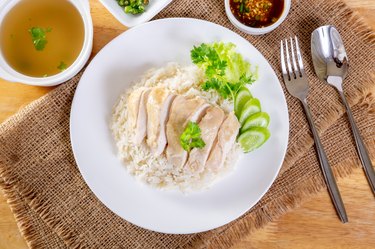
Many people view steamed chicken breast as the dietary symbol of healthy eating. It's low in fat, it has a lot of lean protein and it's easy to whip up. But when you're trying to put healthier options on your plate, it doesn't mean you have to resort to a bland steamed chicken and vegetables recipe.
When making steamed chicken, marinade and/or lots of herbs and spices can help bring out the flavors of the chicken without changing its nutritional profile too much. Just make sure you're using homemade marinades so you can control the ingredients and herbs and spices that don't have any added sugar or too much salt.
Video of the Day
Video of the Day
Making Steamed Chicken Breast
The California Department of Social Services calls steaming a quick and healthy way to cook foods because it adds no extra fat or calories. When steaming, you simply use a little bit of water in a heated element, like the stove or microwave, to create steam that helps keep food moist while it's cooking.
While it is possible to steam food in the microwave, the best way to make steamed chicken breast (or any kind of chicken) is in the oven. To start, preheat the oven to 350 degrees Fahrenheit. Place each chicken breast on a square of aluminum foil and season with salt and pepper. Fold the ends of the foil to create a pocket and seal tightly. Fill the bottom of a roasting pan with about one-half inch of water and place prepared chicken packets in the pan. Cook for 20 minutes or until chicken is cooked through, and you're done!
Steaming isn't the only way to make a healthy chicken dish, though. The Academy of Nutrition and Dietetics notes that grilling, roasting and baking are also good options. Regardless of the method you choose, always make sure your chicken is cooked to an internal temperature of 165 degrees F before eating it.
Improving the Flavor
When making steamed chicken, marinade can help improve the flavor, but you have to be careful about the types of marinades you're using. Bottled varieties may be convenient, but they often contain lots of added sugar and salt that can quickly turn your healthy chicken into anything but.
According to the USDA, just 1 tablespoon of store-bought marinade can contain 7 grams of sugar plus a whopping 790 milligrams of sodium. And when marinading chicken breasts, you'd use far more than a single tablespoon. You can make your own healthy chicken marinade by combining olive oil, fresh lemon juice, a small amount of raw honey, garlic cloves, salt and pepper.
If you want to forego the marinade, you can use plenty of dried herbs and spices instead. Simply sprinkle the spices generously on both sides of the chicken before steaming.
Choosing Thighs or Breasts
Now that you know how to make steamed chicken, you may be left wondering, "What's healthier: chicken thighs or breasts?" The answer is: They can both be good choices. According to the USDA, 4 ounces of chicken breast contains 172 calories, 4 grams of total fat and 0.8 grams of saturated fat.
Read more: General Nutritional Facts About Chicken
Chicken thighs have almost an identical amount of calories (173 for the same serving size), but they do have more total fat and saturated fat — about 8 grams and 2.3 grams, respectively. Even so, you can include both options in your healthy diet, since they're both rich in lean protein. A 4-ounce serving of chicken breast contains 32.2 grams, while the same portion of chicken thighs comes in slightly lower, at 24.4 grams.
The Academy of Nutrition and Dietetics recommends watching your portion sizes, especially if you're opting for chicken thighs, and removing any skin before eating the chicken.
- USDA FoodData Central: "Chicken, Thigh, Roasted, Broiled, or Baked, Skin Not Eaten"
- USDA FoodData Central: "Chicken Marinade"
- Academy of Nutrition and Dietetics: "Breasts vs Thighs Which Is More Nutritious"
- USDA FoodData Central: "Chicken, Breast, Roasted, Broiled, or Baked, Skin Not Eaten"
- California Department of Social Services: "Steaming is a Quick and Healthy Way to Cook Foods"